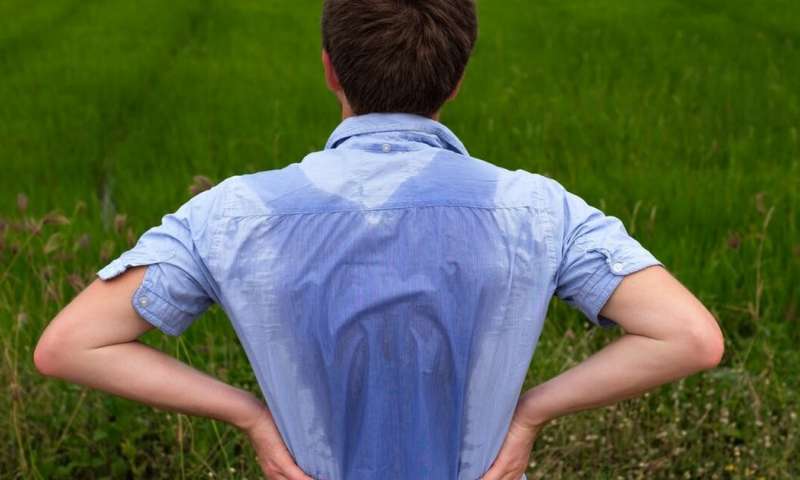Hyperhidrosis is the excessive sweating of both feet. Men experience sweaty feet disorder more than women. However, young adults also experience its symptoms. Testing and trials are performed to address how to stop sweaty feet. The Hyperhidrosis Society reports that more than five percent of the U.S. population suffers from this sweaty condition.
Unfortunately, medical researchers have yet to figure out why excessive sweaty feet happens. Naturally, we all sweat when it is hot outside or if we are involved in high-intensity activities. But, people with hyperhidrosis sweat all too often and throughout the day.
What podiatrists can surmise is that hyperhidrosis can occur when we are overstimulated. The chemicals from being overstimulated make the sweat glands in the feet and other body parts to become reanimated. Overstimulation can occur as a result of menopause, thyroid problems, a heart attack, or certain illnesses.

A hyperhidrosis condition causes people who wear regular shoes to slip around inside their shoes causing sliding, blisters, and infection because their sweating is so prominent.
Symptoms
Symptoms of hyperhidrosis include a whitish appearance, wetness, and sometimes foot infections that cause foot odors. Individuals who suffer from this foot condition feel embarrassed and filled with anxiety.
Types of Hyperhidrosis
There are two types of hyperhidrosis – primary and secondary:
Primary Focal
Primary focal hyperhidrosis is the name of sweaty food conditions. Sweating occurs on both feet at the same time. Hyperhidrosis also refers to sweating in other parts of the body, like the underarms, face, head, and hands. Interestingly, primary focal hyperhidrosis only happens during the day time and not when we are sleeping. Primary focal hyperhidrosis can begin in early childhood or in adolescence.
Secondary Generalized
Secondary generalized hyperhidrosis occurs as the result of a medical problem (cancer, thyroid, diabetes) or a side effect from a prescription drug. Secondary hyperhidrosis occurs on many other parts of the body on a larger sweaty scale.
Unlike primary focal hyperhidrosis, secondary generalized hyperhidrosis affects people even when they are sleeping. Secondary generalized hyperhidrosis only starts in adulthood. The most common secondary hyperhidrosis areas include the same body parts of the primary focus hyperhidrosis, including the whole body and/or the groin area.
Diagnosis and Helpful Tips
At this time for a proper diagnosis, podiatrists and specialized physicians offer a test called the starch-iodine test. This is a solution that is applied to the feet. When it dries, cornstarch is applied. If your feet turn blue, you have hyperhidrosis.
Treatments are customized for each patient. Generally, physicians prescribe patients to use a roll-on antiperspirant. Botox is also a temporary (6 to 9 months) consideration. Also, oral medications are prescribed.
As a near last resort, a “sympathectomy” is performed where surgery is performed on the nerves that affect sweating. Another non-invasive procedure for sweaty feet is called “iontophoresis.”
This procedure uses water with an electrical current that is placed through the skin. Not only can physicians perform this treatment but there are at-home machines on the market that perform the same procedure.
Home-grown, preventive, or tolerable suggestions are also suggested for patients to perform each day. These include washing and drying your feet a couple of times each day. When drying them, apply the antiperspirant, foot powder, or cornstarch. It is suggested that hyperhidrosis patients wear natural or acrylic fiber blend socks that trap and draw sweat away from the skin.
Physicians also suggest the best footwear that can help people. Patients helped doctors through their trial and errors to identify the best type of shoes when experiencing hyperhidrosis episodes. These have included natural and organic type materials like canvas, leather, suede, or jelly-toed material. The materials wear best because they are also man-made fibers that are porous and breathable.
If hyperhidrosis individuals live in an area where there is continual sunshine, physicians have gone so far as to suggest that they go barefooted or wear open sandals. Clinicians further suggest that individuals try relaxation techniques. The techniques suggested are yoga and/or meditation, to help you control any stress or anxiety-filled times when hyperhidrosis is made worse.
What We Go Through
Hyperhidrosis is also considered to be prejudiced against. Individuals with hyperhidrosis may not be hired because their hands may sweat too much to operate equipment, wear latex gloves, or use a law enforcement weapon.
Even though hyperhidrosis is not experienced continually each day, the episodes are uninvited. Hyperhidrosis patients can sweat for just a few minutes, but it is heavy, profuse sweating, not just a few drops no matter what season it is, even in the winter. Let’s hope for a cure soon!

